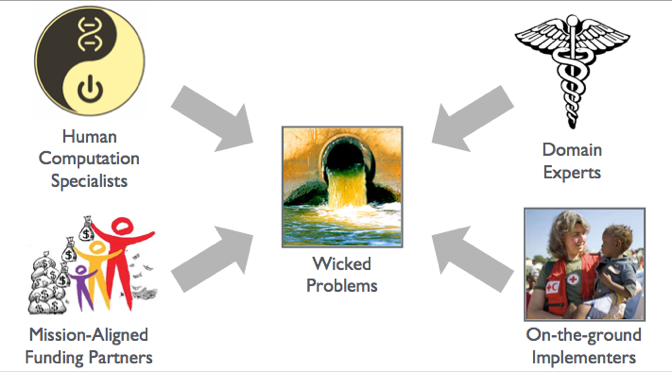
Human computation (HC), which encompasses methods such as crowdsourcing, citizen science, and distributed knowledge collection offers new promise for addressing wicked problems, by enabling participatory sensing, group intelligence, and collective action at unprecedented scales.
The combination of human and computer intelligence might be just what we need to solve the “wicked” problems of the world, such as climate change and geopolitical conflict, say researchers from the Human Computation Institute (HCI) and Cornell University. They present a new vision of human computation (the science of crowd-powered systems), which pushes beyond traditional limits, and takes on hard problems that until recently have remained out of reach.
Humans surpass machines at many things, ranging from simple pattern recognition to creative abstraction. With the help of computers, these cognitive abilities can be effectively combined into multidimensional collaborative networks that achieve what traditional problem-solving cannot. Most of today’s human computation systems rely on sending bite-sized ‘micro-tasks’ to many individuals and then stitching together the results. Eg, 165,000 volunteers in EyeWire have analyzed thousands of images online to help build the world’s most complete map of human retinal neurons.
This microtasking approach alone cannot address the tough challenges we face today. A radically new approach is needed to solve problems that involve many interacting systems that are constantly changing, and whose solutions have unforeseen consequences (e.g., corruption resulting from financial aid given in response to a natural disaster). New human computation technologies can help. Recent techniques provide real-time access to crowd-based inputs, where individual contributions can be processed by a computer and sent to the next person for improvement or analysis of a different kind.
This idea is already taking shape in several human computation projects, including YardMap.org launched by the Cornell in 2012 to map global conservation efforts one parcel at a time. “By sharing and observing practices in a map-based social network, people can begin to relate their individual efforts to the global conservation potential of living and working landscapes,” says Prof. Janis Dickinson. YardMap allows participants to interact and build on each other’s work – something that crowdsourcing alone cannot achieve.
HCI has recently set out to use crowd-power to accelerate Cornell-based Alzheimer’s disease research. WeCureAlz.com combines 2 successful microtasking systems into an interactive analytic pipeline that builds blood flow models of mouse brains. The stardust@home system, which was used to search for comet dust in one million images of aerogel, is being adapted to identify stalled blood vessels, which will then be pinpointed in the brain by a modified version of the EyeWire system.
“By enabling members of the general public to play some simple online game, we expect to reduce the time to treatment discovery from decades to just a few years”, says HCI director and lead author, Dr. Pietro Michelucci.
http://humancomputation.org/ http://www.eurekalert.org/pub_releases/2015-12/hci-hsc121815.php








Recent Comments